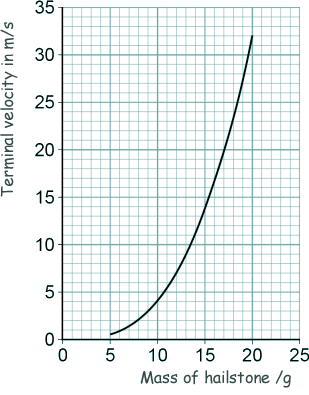GCSE Questions: Forces
Q32. Hailstones are small balls of ice.
Hailstones form in clouds and fall to the ground.
The photo shows different-sized hailstones.

(a) A hailstone falls from a cloud and accelerates.
(i) Why does the hailstone accelerate?
[1 mark]
(ii) The hailstone stops accelerating and reaches terminal velocity.
Explain why the hailstone reaches terminal velocity.
[3 marks]
(b) The kinetic energy of a hailstone is measured in joules.
Which of the following is the same as 1 joule?
(c) A scientist investigated how the mass of hailstones affects their terminal velocity.
The graph below shows the results of her investigation.

(i) Tick one of the following to explain why terminal velocity increases with mass:
| As mass increases the cross-sectional surface area of a hailstone increases. |
|
| As mass increases the volume of a hailstone increases. |
|
| As mass increases the weight of a hailstone increases. |
|
[1 mark]
(ii) Explain the difference in the maximum kinetic energy of a hailstone with a mass of
10 g and a hailstone with a mass of 20 g.
[3 marks]
(iii) A hailstone hit the ground at its terminal velocity of 25 m/s.
The hailstone took 0.060 s to stop moving.
Using information from graph above, determine the average force on the hailstone as it hits the ground.
[3 marks]
[12 Marks TOTAL]









